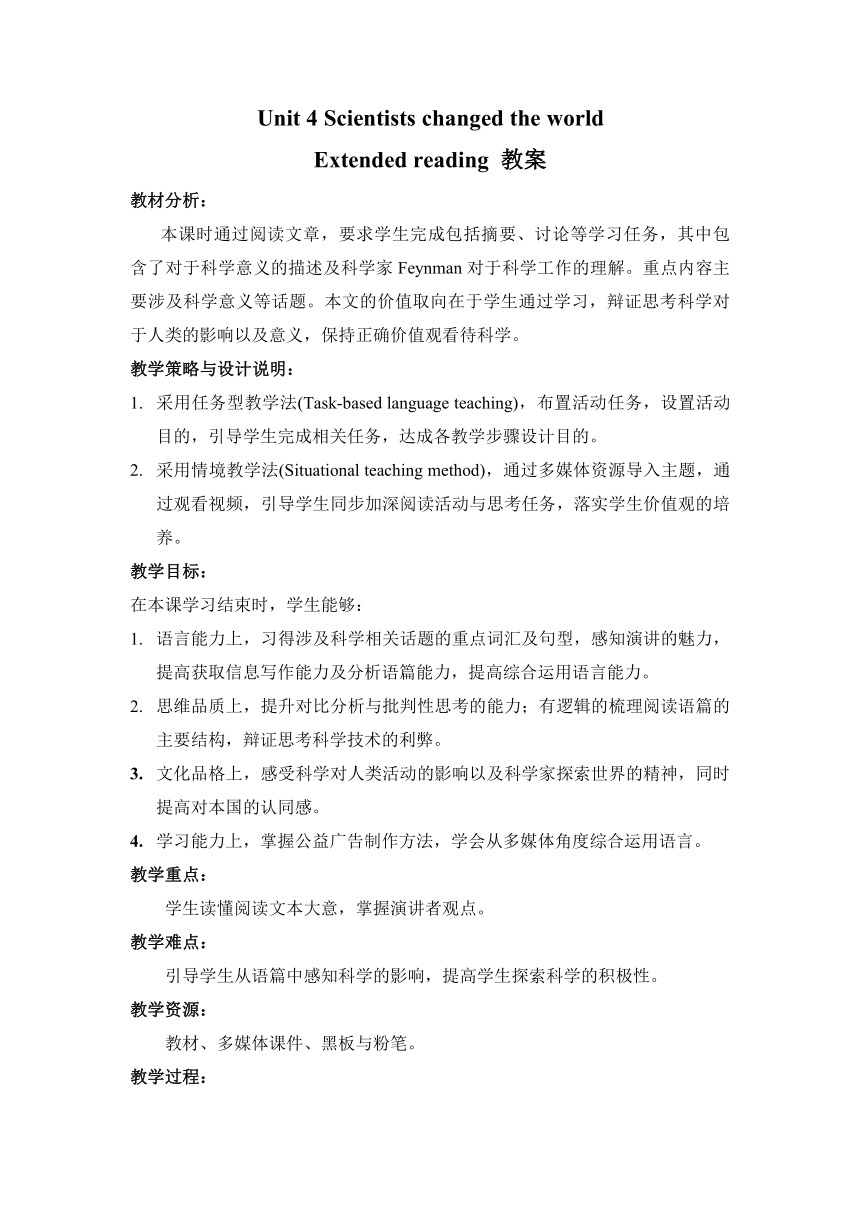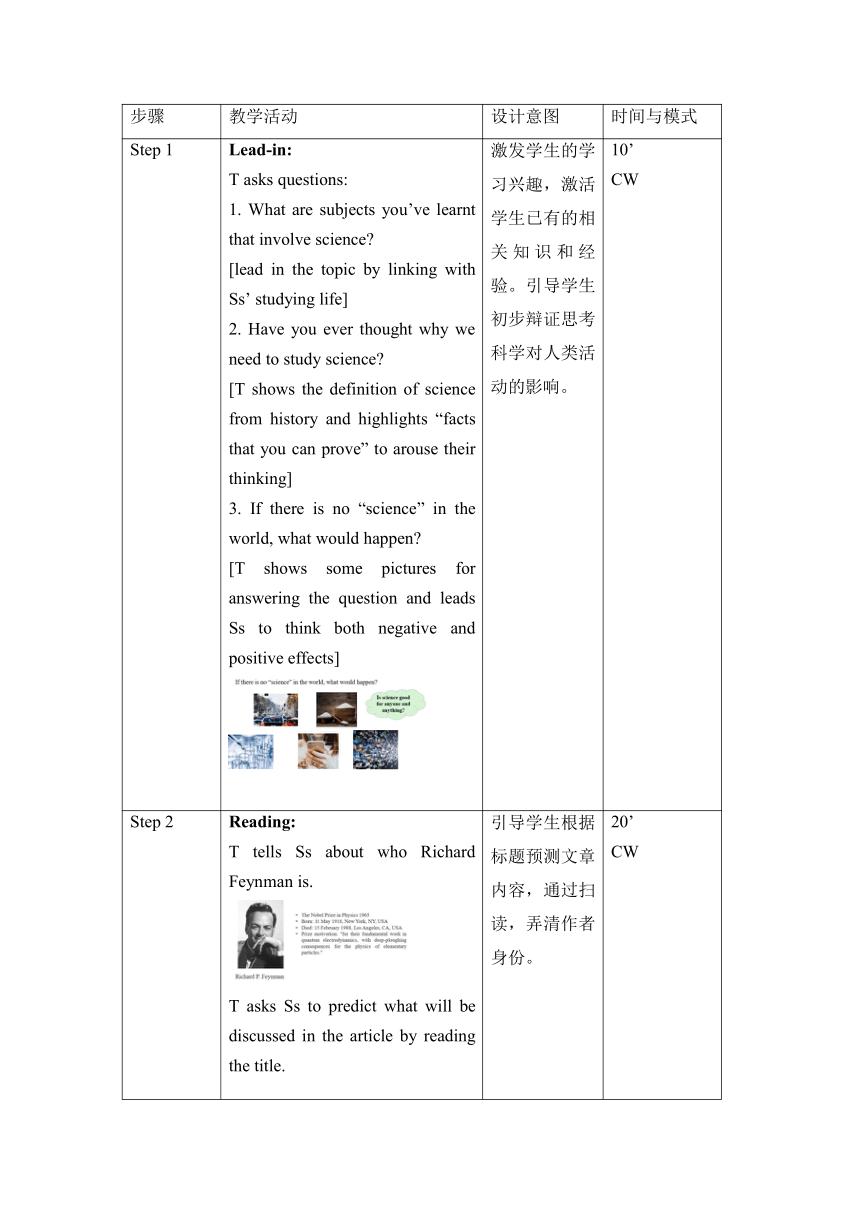牛津译林版(2019)必修第三册Unit4 Scientists who changed the world Extended reading 教案(表格式)
文档属性
| 名称 | 牛津译林版(2019)必修第三册Unit4 Scientists who changed the world Extended reading 教案(表格式) |

|
|
| 格式 | docx | ||
| 文件大小 | 385.8KB | ||
| 资源类型 | 教案 | ||
| 版本资源 | 牛津译林版(2019) | ||
| 科目 | 英语 | ||
| 更新时间 | 2024-04-04 22:03:35 | ||
图片预览


文档简介
Unit 4 Scientists changed the world
Extended reading 教案
教材分析:
本课时通过阅读文章,要求学生完成包括摘要、讨论等学习任务,其中包含了对于科学意义的描述及科学家Feynman对于科学工作的理解。重点内容主要涉及科学意义等话题。本文的价值取向在于学生通过学习,辩证思考科学对于人类的影响以及意义,保持正确价值观看待科学。
教学策略与设计说明:
采用任务型教学法(Task-based language teaching),布置活动任务,设置活动目的,引导学生完成相关任务,达成各教学步骤设计目的。
采用情境教学法(Situational teaching method),通过多媒体资源导入主题,通过观看视频,引导学生同步加深阅读活动与思考任务,落实学生价值观的培养。
教学目标:
在本课学习结束时,学生能够:
语言能力上,习得涉及科学相关话题的重点词汇及句型,感知演讲的魅力,提高获取信息写作能力及分析语篇能力,提高综合运用语言能力。
思维品质上,提升对比分析与批判性思考的能力;有逻辑的梳理阅读语篇的主要结构,辩证思考科学技术的利弊。
文化品格上,感受科学对人类活动的影响以及科学家探索世界的精神,同时提高对本国的认同感。
学习能力上,掌握公益广告制作方法,学会从多媒体角度综合运用语言。
教学重点:
学生读懂阅读文本大意,掌握演讲者观点。
教学难点:
引导学生从语篇中感知科学的影响,提高学生探索科学的积极性。
教学资源:
教材、多媒体课件、黑板与粉笔。
教学过程:
步骤 教学活动 设计意图 时间与模式
Step 1 Lead-in: T asks questions: 1. What are subjects you’ve learnt that involve science [lead in the topic by linking with Ss’ studying life] 2. Have you ever thought why we need to study science [T shows the definition of science from history and highlights “facts that you can prove” to arouse their thinking] 3. If there is no “science” in the world, what would happen [T shows some pictures for answering the question and leads Ss to think both negative and positive effects] 激发学生的学习兴趣,激活学生已有的相关知识和经验。引导学生初步辩证思考科学对人类活动的影响。 10’ CW
Step 2 Reading: T tells Ss about who Richard Feynman is. T asks Ss to predict what will be discussed in the article by reading the title. Then, first reading, Ss need to catch the main idea and fill in the graph. Next, T leads Ss to analyse the contents for each paragraph (leading sentence, linking words, structure, details etc.). While analysing the speech context, T can also ask some question related to the para. 引导学生根据标题预测文章内容,通过扫读,弄清作者身份。 引导学生理清文章脉络,把握文章的基本信息,为培养学生的高阶思维能力做铺垫。组织问答活动,充分调动学生语言能力。 20’ CW
Step 3 Discussion: T highlights the changes of Feynman’s thought. And T asks what the value of science is for you 激活新知,表达观点,学生表达自己对话题的真实感受,加强学生与文本的联系。 5’ CW
Step 4 Writing: T leads Ss to complete the summary task A. Alternatively, T can give some hints or main points of the passage. 梳理文章细节,帮助学生调动新知和语言能力完成写作任务。 8’ CW
Step 5 Discussion: T asks the question in task B and shows the line of scientists’ thought. Then, T asks two more questions to arouse their inspiration of science exploring. Finally, T plays a short video: Feynman’s interview about how to cultivate the awareness of science. 通过回答问题,学生提高对科学探索的兴趣。播放Feynman采访的片段,加深对人物与文章主旨的理解。 8’ CW
Step 6 Practice: Imagine you have a chance to interview Richard Feynman, what questions would you like to ask him And ask these questions to your partners, take notes what they say. Suggested questions: Do you have any suggestions to give to young students … 锻炼学生的发散性思维,通过创设与作者互动的情境,引导学生认真思考,拓宽学生思维的深度与广度。综合运用语言,提高语言能力和学习能力。 10’ GW
Step 7 Homework: Search more interviews of Richard Feynman and write a short reflection. 巩固新知,复习语篇,为下节课做准备。 1’
备注:
Ss: Students T: Teacher
IW: Individual work GW: Group work CW: Class work
教学反思:
学生通过本课时学习,能否理解阅读文本主要内容,并能逻辑清晰地梳理出文章大意与主要结构。
学生通过本课时学习,能否加深对科学意义和科学家精神的理解。
学生能否完成自主摘要写作的任务。
学生能够提高对科学探索的兴趣。
Extended reading 教案
教材分析:
本课时通过阅读文章,要求学生完成包括摘要、讨论等学习任务,其中包含了对于科学意义的描述及科学家Feynman对于科学工作的理解。重点内容主要涉及科学意义等话题。本文的价值取向在于学生通过学习,辩证思考科学对于人类的影响以及意义,保持正确价值观看待科学。
教学策略与设计说明:
采用任务型教学法(Task-based language teaching),布置活动任务,设置活动目的,引导学生完成相关任务,达成各教学步骤设计目的。
采用情境教学法(Situational teaching method),通过多媒体资源导入主题,通过观看视频,引导学生同步加深阅读活动与思考任务,落实学生价值观的培养。
教学目标:
在本课学习结束时,学生能够:
语言能力上,习得涉及科学相关话题的重点词汇及句型,感知演讲的魅力,提高获取信息写作能力及分析语篇能力,提高综合运用语言能力。
思维品质上,提升对比分析与批判性思考的能力;有逻辑的梳理阅读语篇的主要结构,辩证思考科学技术的利弊。
文化品格上,感受科学对人类活动的影响以及科学家探索世界的精神,同时提高对本国的认同感。
学习能力上,掌握公益广告制作方法,学会从多媒体角度综合运用语言。
教学重点:
学生读懂阅读文本大意,掌握演讲者观点。
教学难点:
引导学生从语篇中感知科学的影响,提高学生探索科学的积极性。
教学资源:
教材、多媒体课件、黑板与粉笔。
教学过程:
步骤 教学活动 设计意图 时间与模式
Step 1 Lead-in: T asks questions: 1. What are subjects you’ve learnt that involve science [lead in the topic by linking with Ss’ studying life] 2. Have you ever thought why we need to study science [T shows the definition of science from history and highlights “facts that you can prove” to arouse their thinking] 3. If there is no “science” in the world, what would happen [T shows some pictures for answering the question and leads Ss to think both negative and positive effects] 激发学生的学习兴趣,激活学生已有的相关知识和经验。引导学生初步辩证思考科学对人类活动的影响。 10’ CW
Step 2 Reading: T tells Ss about who Richard Feynman is. T asks Ss to predict what will be discussed in the article by reading the title. Then, first reading, Ss need to catch the main idea and fill in the graph. Next, T leads Ss to analyse the contents for each paragraph (leading sentence, linking words, structure, details etc.). While analysing the speech context, T can also ask some question related to the para. 引导学生根据标题预测文章内容,通过扫读,弄清作者身份。 引导学生理清文章脉络,把握文章的基本信息,为培养学生的高阶思维能力做铺垫。组织问答活动,充分调动学生语言能力。 20’ CW
Step 3 Discussion: T highlights the changes of Feynman’s thought. And T asks what the value of science is for you 激活新知,表达观点,学生表达自己对话题的真实感受,加强学生与文本的联系。 5’ CW
Step 4 Writing: T leads Ss to complete the summary task A. Alternatively, T can give some hints or main points of the passage. 梳理文章细节,帮助学生调动新知和语言能力完成写作任务。 8’ CW
Step 5 Discussion: T asks the question in task B and shows the line of scientists’ thought. Then, T asks two more questions to arouse their inspiration of science exploring. Finally, T plays a short video: Feynman’s interview about how to cultivate the awareness of science. 通过回答问题,学生提高对科学探索的兴趣。播放Feynman采访的片段,加深对人物与文章主旨的理解。 8’ CW
Step 6 Practice: Imagine you have a chance to interview Richard Feynman, what questions would you like to ask him And ask these questions to your partners, take notes what they say. Suggested questions: Do you have any suggestions to give to young students … 锻炼学生的发散性思维,通过创设与作者互动的情境,引导学生认真思考,拓宽学生思维的深度与广度。综合运用语言,提高语言能力和学习能力。 10’ GW
Step 7 Homework: Search more interviews of Richard Feynman and write a short reflection. 巩固新知,复习语篇,为下节课做准备。 1’
备注:
Ss: Students T: Teacher
IW: Individual work GW: Group work CW: Class work
教学反思:
学生通过本课时学习,能否理解阅读文本主要内容,并能逻辑清晰地梳理出文章大意与主要结构。
学生通过本课时学习,能否加深对科学意义和科学家精神的理解。
学生能否完成自主摘要写作的任务。
学生能够提高对科学探索的兴趣。
同课章节目录
- Unit 1 Nature in the balance
- Welcome to the unit
- Reading
- Grammar and usage
- Integrated skills
- Extended reading
- Project
- Unit 2 Natural disasters
- Welcome to the unit
- Reading
- Grammar and usage
- Integrated skills
- Extended reading
- Project
- Unit 3 The world online
- Welcome to the unit
- Reading
- Grammar and usage
- Integrated skills
- Extended reading
- Project
- Unit 4 Scientists who changed the world
- Welcome to the unit
- Reading
- Grammar and usage
- Integrated skills
- Extended reading
- Project
